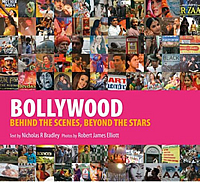BOOK REVIEW:
It was the usual routine - this reviewer was trying to read
his book during a jam-packed train ride home when the following
incident happened. It didn’t occur to him that he was
passing through Little India station, also known as the center
where you can find the largest Indian community in Singapore.
You
see, the colorful pictures in this book attracted many Indian
foreign workers around him, probably because the images were
an assuring and familiar sight to them in this foreign land.
The
well-printed book focuses on the Bollywood film industry in
Bombay, where about 150 to 200 movies are produced annually
(contributing to the yearly national average of about 800).
The hustles and bustles of the city are described in text
written by Nicholas R. Bradley, as well as lavishly-shot photographs
taken by Robert James Elliot.
In
fact, the many pictures in this book are probably what you’d
remember fondly after reading the book.
Bombay
as a city; its developments; the music and stars of Bollywood;
and the people who work behind the camera: these chapters
together form the full picture of this book.
From
the easily comprehensible write-ups, readers can learn about
Indian film history (no, Bollywood movies did not start off
featuring the now-popular dance and song sequences), the thematic
trends in Bollywood movies, the power the stars command and
how recent developments in the industry has impacted the country
locally and internationally. These interesting facts are written
by Bradley in a brief and concise manner, which will definitely
sustain your interest level.
The
gorgeous complementary pictures feature people leading their
everyday lives in the city, movie stars like Amitabh Bachchan,
Shah Rukh Khan and Preity Zinta looking their best, hardworking
crew preparing for shoots, amongst other defining moments
caught Elliot’s camera. The photographs simply beg your
eyes’ attention.
Those
familiar with Bollywood productions will have a good time
reading about titles like Lagaan (2001), Kabhi Khushi Kabhie
Gham (2001) and Hum Ko Deewana Kar Gaye (2006). If not, this
might just be the book to spark your interest.
While
we at this part of the world continue to be amazed by the
recent slew of Bollywood productions like Krrish, Kabhi Alvida
Naa Kehna and Dhoom: 2, there is a part in this reviewer who
thinks that we may simply be escaping into Bollywood’s
world of exoticism.
Bombay
is portrayed as a city in this book where wishes can come
true for anyone in the large population, as long as he or
she dares to dream. But as the book briefly mentions in its
opening chapters, the reality in Bombay is a sad one.
And
from the eyes of the foreign workers beside me on the train,
I could sense this harsh truth.
CHOICE XCERPT:
“It is not uncommon to find a taxi driver with a self-penned
screenplay or two stuffed in his pocket on the off chance
that his passenger could turn out to be his entry ticket into
the industry. Cafes reputedly frequented by Bollywood directors
and producers are more often the haunts of budding writers
and actors, pinning back their desperation with hopes of a
chance encounter with someone who could change their lives
forever. At times it seems that almost everyone in the city
is just waiting for their break into the promised land of
films.”
VERDICT:
Definitely more interesting than your average film studies
textbook, this comprehensive and visually-enticing book is
a fine guide into the world of Bollywood movies.
   
Review
by John Li
|

